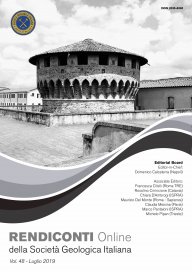
First report of Sclerobiont Bryozoans in the Maiolica Fm. of the Umbria-Marche Basin (Northern Apennines, Italy)
Simone Fabbi (1), Angelo Cipriani (1), Paolo Citton (2) & Marco Romano (3)
(1) Dipartimento di Scienze della Terra, Sapienza Università di Roma, P.le Aldo Moro, 5, 00185, Rome, Italy.
(2) CONICET-Consejo Nacional de Investigaciones Científicas y Técnicas. IIPG-Instituto de Investigación en Paleobiología y Geología, Av. Roca 1242 (8332), General
Roca, p.cia. de Río Negro, Argentina.
(3) Evolutionary Studies Institute (ESI), School of Geosciences, University of the Witwatersrand, Johannesburg, South Africa.
Corresponding author e-mail: simone.fabbi@uniroma1.it
DOI: https://doi.org/10.3301/ROL.2019.43
Volume: 48/2019
Pages: 106-111
Abstract
We describe the first evidence of sclerobiont bryozoans found loose in the pelagic Maiolica Fm. of the Umbria-Marche Basin (Monte Acuto Massif, Northern Apennines, Italy). The material is represented by three small sub-circular colonies with tube-shaped zooecia radially developing from the centre. These characters are not enough for generic or specific classification, consequently, these cyclostomes have been only identified as belonging to the Suborder Tubuliporina.
Calpionellid assemblages allow to constrain the bryozoan-bearing rock sample to the early Berriasian. The occurrence of isolated bryozoans in the Maiolica Fm. enriches the knowledge about the fauna of this unit in pure basinal settings, composed by radiolarians, calpionellids, dinoflagellate cysts and rare macrofossils (ammonites and aptychi), including very rare benthic organisms (gastropods, brachiopods and bivalves). Up to date, no sclerobiont organisms in ‘normal’ pelagic
Maiolica facies were known, due to the lack of suitable substrates to be colonised. Encrustation of a planktonic or nektonic hard-shelled organism seems the most parsimonious hypothesis based on our material.
Keywords
Get Full Text